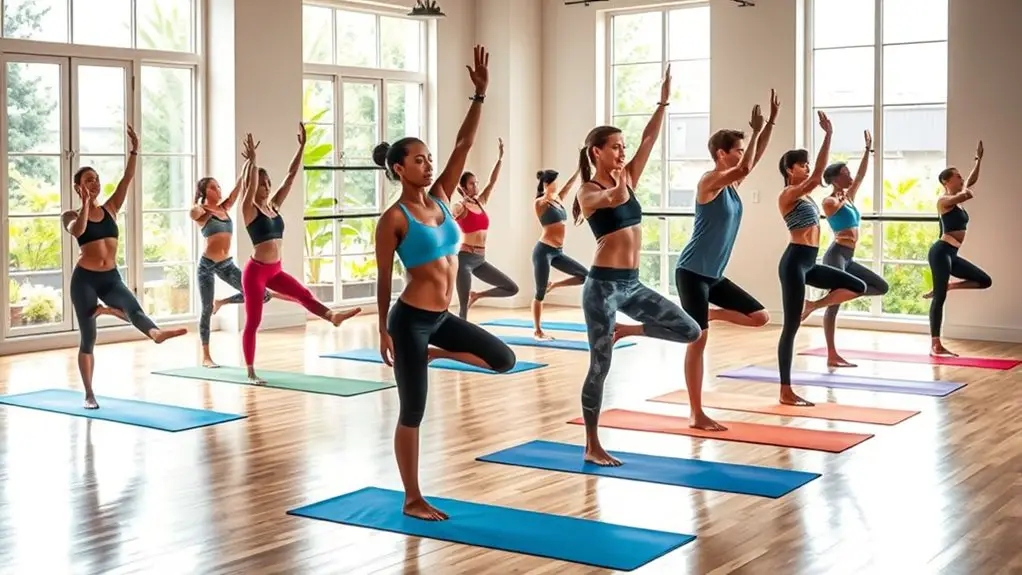The Role of Flexibility and Stretching in Injury Prevention

Flexibility and stretching are essential for preventing injuries as they enhance muscle elasticity and improve your range of motion. Regular stretching increases blood flow to your muscles, reduces tension, and prepares your body for physical activity, which diminishes the risk of strains and sprains. Incorporating various stretching techniques into your routine, both before and after workouts, not only supports recovery but can also boost your performance. Discovering effective ways to maintain flexibility will further enhance your overall well-being.
Understanding Flexibility and Its Benefits

Although many people associate flexibility solely with improved athletic performance, its benefits extend far beyond that. Flexibility is vital for overall physical health, influencing posture, balance, and joint function. Many flexibility misconceptions suggest that it only matters for athletes or that it can prevent injuries without considering other factors. In reality, flexibility aids in muscle recovery and can enhance daily functional movements, making everyday activities easier.
Flexibility myths often imply that static stretching is the only way to improve this range of motion; however, dynamic stretches and regular movement contribute greatly. Research shows that maintaining flexibility can reduce the risk of chronic pain and improve circulation. It’s important to recognize that flexibility is not static; it requires consistent practice and varies among individuals. Understanding these aspects can help you incorporate flexibility into a balanced fitness routine, ultimately leading to a healthier, more functional body.
The Importance of Stretching in Physical Activity
Stretching plays an essential role in physical activity by enhancing your range of motion and improving overall muscle performance. Research shows that incorporating regular stretching can greatly reduce the risk of injuries during exercise. By prioritizing stretching, you can optimize your physical performance and maintain a healthier, more flexible body.
Enhanced Range of Motion
Flexibility plays an essential role in enhancing the range of motion, which is important for ideal physical activity. When you improve your flexibility, you’re not just enhancing your performance; you’re also actively participating in injury prevention. A greater range of motion allows for more efficient movement, reducing strain on muscles and joints. Incorporating stretching into your routine can lead to significant benefits for anyone leading an active lifestyle.
| Type of Stretching | Benefits |
|---|---|
| Static | Increases flexibility |
| Dynamic | Prepares muscles |
| Ballistic | Enhances speed |
| Proprioceptive | Improves coordination |
| Active | Strengthens muscles |
Incorporating these types can help you achieve your physical goals while minimizing the risk of injury.
Improved Muscle Performance
Effective stretching techniques can greatly enhance muscle performance during physical activity. Incorporating stretching into your routine improves muscle elasticity, allowing your muscles to stretch and contract more efficiently. When you enhance muscle elasticity, you can achieve greater strength and power outputs, which directly contributes to performance enhancement. Research shows that dynamic stretching before activity prepares the muscles for exertion, maximizing their function. Additionally, improved flexibility helps in maintaining ideal muscle length, reducing the energy required for movement. This increased efficiency can lead to better endurance and overall athletic performance. Consequently, integrating consistent stretching practices can be essential for anyone looking to maximize their physical capabilities and achieve their fitness goals.
Injury Risk Reduction
While many people focus on strength and endurance, neglecting flexibility can greatly increase the risk of injury during physical activity. Injury prevention should be a priority, and incorporating flexibility training into your routine can make a significant difference.
Consider the following benefits of stretching:
- Enhances range of motion in joints
- Reduces muscle tension and soreness
- Improves blood circulation to muscles
- Increases body awareness and coordination
- Lowers the likelihood of strains and sprains
Common Types of Stretching Techniques
Stretching techniques play an essential role in enhancing physical performance and preventing injuries. Two common types are ballistic stretching and PNF (Proprioceptive Neuromuscular Facilitation) stretching.
Ballistic stretching involves using momentum to push a body part beyond its normal range of motion. While it can increase flexibility quickly, it carries a higher risk of injury due to the jerky movements involved. It’s generally recommended for athletes familiar with their bodies and under supervision.
On the other hand, PNF stretching combines passive stretching and isometric contractions. Typically, it requires a partner to assist, enhancing flexibility more safely. This method engages the nervous system, allowing for greater gains in range of motion and has been shown to be effective in rehabilitation settings.
Incorporating these techniques into your routine can lead to improved performance, but always approach with caution, especially with ballistic methods.
How Flexibility Reduces Injury Risk

Incorporating flexibility into your fitness routine is essential for reducing injury risk. Enhancing your flexibility not only improves your range of motion but also aids in developing proprioceptive awareness, which helps you better understand your body’s position in space. This awareness is vital for maintaining balance and preventing falls.
Here are some key benefits of flexibility:
- Improves joint mobility: Greater flexibility helps joints move through their full range without strain.
- Enhances muscle performance: Flexible muscles can contract more efficiently, reducing the likelihood of tears.
- Promotes dynamic flexibility: This involves active movements that prepare muscles for physical activity, further reducing injury risk.
- Reduces muscle tension: Less tension leads to better overall function and lowers the chance of strains.
- Facilitates recovery: Increased flexibility aids in faster recovery post-exercise, helping you stay active and injury-free.
The Science Behind Muscle Tension and Recovery
Understanding how muscle tension impacts recovery is essential for maximizing athletic performance and injury prevention. When muscles experience excessive tension, it can hinder blood flow and nutrient delivery, slowing down muscle recovery. Elevated tension levels can lead to micro-tears in muscle fibers, causing delayed-onset soreness and increasing injury risk.
Incorporating tension release techniques, such as stretching and foam rolling, can enhance recovery by promoting circulation and reducing stiffness. Research indicates that these practices help to alleviate tightness, allowing muscles to relax and recover more effectively.
Additionally, maintaining ideal flexibility directly correlates with muscle health and performance. When you address muscle tension promptly, you facilitate quicker recovery times and improve overall function. By prioritizing tension release strategies, you can create a robust framework for sustained athletic performance while minimizing the likelihood of injuries.
Incorporating Flexibility Training Into Your Routine

Improving flexibility should be a key component of any training regimen, especially for athletes aiming to enhance performance and reduce the risk of injuries. Incorporating flexibility training into your routine can be straightforward with the right approach. Start by conducting flexibility assessments to identify areas needing improvement. Here are some effective strategies:
- Schedule regular stretching routines: Aim for at least 2-3 sessions per week.
- Focus on major muscle groups: Target hamstrings, quadriceps, hip flexors, and shoulders.
- Utilize dynamic stretches: Incorporate movements that mimic your sport to enhance functional flexibility.
- Include static stretches: Hold stretches for 15-30 seconds post-exercise to improve overall flexibility.
- Monitor progress: Reassess flexibility periodically to track improvements and adjust your routine accordingly.
Stretching Before vs. After Exercise: What You Need to Know
When it comes to stretching, the timing can greatly impact your performance and recovery. Pre-exercise stretching, particularly dynamic stretching, helps prepare your muscles and joints for activity, while post-workout static stretching is essential for recovery and flexibility. Understanding these differences can enhance your exercise routine and reduce the risk of injury.
Benefits of Pre-Exercise Stretching
While some may question the necessity of stretching before exercise, evidence suggests that engaging in pre-exercise stretching can enhance performance and reduce the risk of injury. Understanding the pre-exercise benefits can help dispel common stretching misconceptions. Here are some key advantages:
- Increases blood flow to muscles, improving oxygen delivery.
- Enhances flexibility, allowing for a greater range of motion.
- Prepares the neuromuscular system for activity, reducing strain.
- Reduces muscle tension, which can lead to better performance.
- May improve overall athletic performance, particularly in dynamic sports.
Incorporating these pre-exercise stretching routines can be essential for maximizing your workout effectiveness and minimizing injury risks. By addressing these misconceptions, you can make informed decisions about your fitness regimen.
Importance of Post-Workout Stretching
Post-workout stretching plays an essential role in recovery, as it helps to maintain flexibility and reduce muscle soreness. Engaging in post-workout stretching can lead to significant post workout benefits, such as improved circulation, which aids in the removal of metabolic waste and enhances nutrient delivery to muscles. Research suggests that stretching after exercise can facilitate recovery enhancement by promoting relaxation and decreasing muscle tension. This practice not only helps prevent stiffness but also contributes to overall muscle health. By incorporating post-workout stretching into your routine, you’re setting yourself up for better performance in future workouts while minimizing the risk of injury. Remember, a few minutes of stretching can make a meaningful impact on your recovery process.
Dynamic vs. Static Stretching
Understanding the differences between dynamic and static stretching is essential for optimizing your workout routine and preventing injuries. Both types serve distinct purposes in your exercise regimen.
Dynamic stretching benefits include:
- Increased blood flow to muscles
- Enhanced range of motion
- Improved athletic performance
- Reduced risk of injury during activities
- Better neuromuscular coordination
You should incorporate dynamic stretching techniques before your workout to prepare your body. Conversely, static stretching techniques, which involve holding a stretch for a period, are best suited for post-exercise recovery. They help improve flexibility and aid in muscle relaxation. By knowing when to use each stretching method, you can effectively enhance your performance while minimizing the risk of injuries.
Flexibility and Performance: Enhancing Your Athletic Abilities
As athletes endeavor to optimize their performance, the role of flexibility often emerges as a vital factor in achieving peak physical capabilities. Flexibility training not only enhances muscle elasticity but also contributes to athletic recovery, allowing for quicker healing and improved overall wellness. By incorporating sport-specific flexibility routines, you can target the muscles most engaged in your activities, promoting agility development and balance improvement. Enhanced flexibility facilitates dynamic movements, which are essential for executing complex athletic tasks efficiently. Furthermore, improved flexibility correlates with better coordination skills, helping to refine your technique and reduce the risk of injury. Evidence suggests that athletes with superior flexibility experience significant performance enhancement, as their bodies can adapt more readily to the demands of their sport. Consequently, prioritizing flexibility training can be a game-changer in elevating your athletic abilities, making it a pivotal element in any extensive training regimen.
Tips for Maintaining Flexibility Over Time

Maintaining flexibility over time is essential for sustaining athletic performance and reducing the risk of injury. To achieve this, consider incorporating the following strategies into your routine:
- Engage in regular yoga practices: These improve overall flexibility while promoting balance and strength.
- Utilize foam rolling: This technique releases muscle tension and enhances blood flow, aiding recovery and flexibility.
- Incorporate dynamic stretches: Perform these before workouts to prepare your muscles for activity, increasing elasticity.
- Schedule consistent stretching sessions: Aim for at least 10-15 minutes daily to maintain and improve flexibility.
- Listen to your body: Pay attention to any tightness or discomfort, adjusting your routine as necessary to avoid injury.
Frequently Asked Questions
How Long Should I Hold Each Stretch for Maximum Benefit?
When you’re focusing on static stretching, holding each stretch for about 15 to 30 seconds is ideal for maximum benefit. This duration allows your muscles to relax and lengthen effectively. In contrast, dynamic stretching is typically performed through continuous movement and doesn’t require holding. Aim for 5 to 10 repetitions of each dynamic stretch. Incorporating both methods into your routine can enhance flexibility and prepare your body for physical activity.
Can Flexibility Training Improve My Overall Athletic Performance?
Yes, flexibility training can greatly improve your overall athletic performance. Research shows that enhanced flexibility benefits range from better range of motion to improved muscle coordination, which can lead to superior strength and speed. By incorporating regular flexibility exercises into your routine, you can optimize your body’s biomechanics, allowing for more efficient movements during athletic activities. This improved efficiency often translates into better performance outcomes in various sports and physical activities.
What Are the Best Times to Incorporate Stretching Into My Day?
To maximize the benefits of stretching, incorporate it into your morning routine and post-workout. Stretching in the morning can enhance circulation and flexibility, preparing your muscles for the day ahead. After your workout, it’s essential to stretch to aid recovery, reduce muscle soreness, and improve flexibility. Research indicates that consistent stretching during these times can notably enhance overall performance and decrease the risk of injury, ensuring you stay active and healthy.
Are There Specific Stretches for Different Types of Sports?
When it comes to preparing your body for the demands of your chosen activity, sport-specific stretches can make all the difference. Each sport has unique movements, so incorporating dynamic stretching tailored to those movements is essential. For instance, runners benefit from leg swings, while swimmers might focus on shoulder rotations. By embracing these targeted techniques, you’re not just enhancing performance; you’re also fostering a more resilient body capable of enduring the rigors of your sport.
How Does Age Affect My Flexibility and Stretching Routine?
As you age, you may notice a flexibility decline due to age-related changes in muscle elasticity and joint mobility. This decline can lead to stiffness and reduced range of motion. To counteract this, it’s essential to adapt your stretching routine, incorporating dynamic stretches and longer hold times to maintain flexibility. Regular stretching can help mitigate these effects, promoting better mobility and overall physical health as you navigate the aging process.





